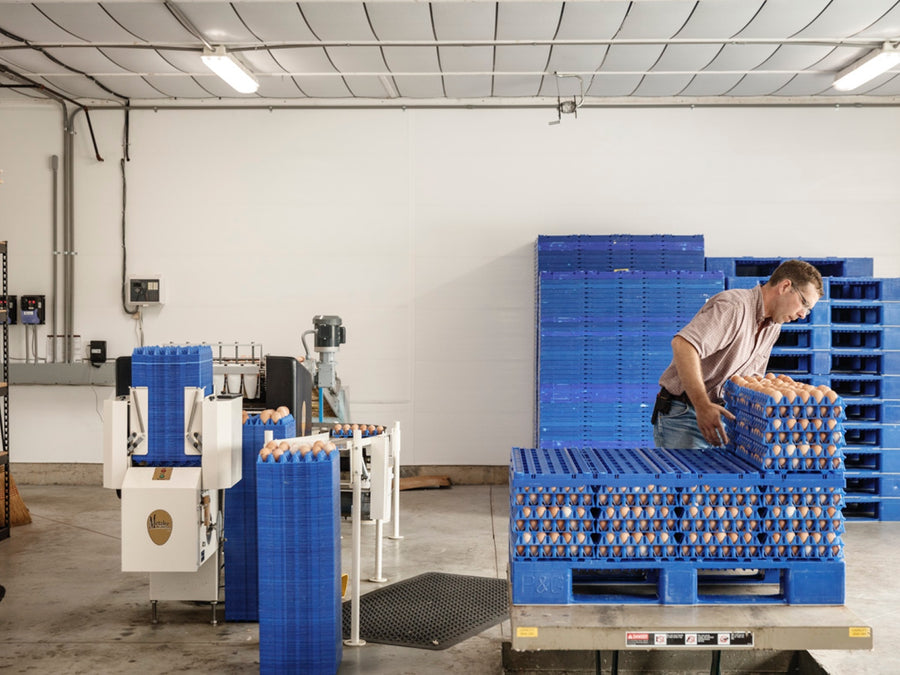
2023 egg prices and fewer options at the store
As we continue to partner with honest, hardworking, and dependable small family farms, the events of recent years have proven that even our responsible business model isn’t immune to the global challenges facing today’s food system. In addition to ongoing pandemic-related and supply chain issues, the egg industry is also dealing with poultry-specific complications such as a record-breaking avian influenza outbreak. In the same way that these obstacles have impacted daily life for many families and individuals, they have also affected our business as a whole.
Long-term impacts of Avian Influenza (H5N1, Bird Flu)
Today, many of the country’s largest egg producers (in most cases, factory farms offering poor living conditions for their hens) are still facing challenges stemming from the avian influenza outbreak that started in January 2022. With a staggering 58 million birds affected in the U.S. as of February 2023, several of these suppliers are now experiencing a shortage of laying hens as they work to rebuild their flocks. This means fewer eggs are making their way onto grocery store shelves, which explains why shoppers have found fewer options or even out-of-stock signs across the egg aisle.
Thankfully, our commitment to Certified Humane animal welfare standards has guided our approach to keeping Pete & Gerry’s small family farms as low-risk as possible. Spacious barns with plenty of room to peck, scratch, and roost make it easier for our flocks to stay healthy. In turn, our hens are continuing to lay and our farmers are still working tirelessly to ensure that we can keep providing a healthy product to families across the nation. Even so, fewer cage-free and conventional eggs on the shelf means more folks are reaching for humane eggs like ours that are more readily available. This is why you may have a harder time finding our Pete & Gerry’s eggs at your local store, or why the price of cage-free or conventional eggs may have increased in your area: with a smaller national egg supply and continued demand for affordable protein-packed food, prices naturally go up.
All in all, we're doing our very best to keep up with demand for nutritious and responsibly raised eggs while ensuring that our own workers and families are safe. We understand that these situations have been changing by the day, which will inevitably result in some empty shelves and delayed shipments. We'll keep striving to get our eggs to your local stores and provide healthy, nutrient-dense food for folks across the country.
2022 inflation and higher grocery bills
We have always been committed to authenticity and transparency as exemplified in the rigorous third-party standards for animal welfare that are upheld on all of our small family farms, in our dedication to organic farming free from pesticides and GMOs, and even in our constant research and efforts to package our eggs in the most sustainable cartons possible. In keeping with that promise to you, we also want to be upfront and honest about the recent price increase in egg prices that you may have noticed during your last trip to pick up a carton or two of Pete & Gerry's Organic Eggs.
Effects of inflation, logistical challenges, and increased costs for farmers
In fact, if you've purchased anything from the grocery store lately, you've probably noticed that the cost of food and household goods as a whole has generally gone up. In other words: it's not just eggs. Meat, fish, canned goods, paper goods, and even pet food are just a few of the items that have become more expensive. These increased costs are a result of many factors, some of which you may have heard about in the news. While inflation hit a 30-year high in late 2021, that's not the full reason. The entire country is grappling with logistical challenges related to labor, driver shortages, and even crop shortages. In the egg world, the cost of high quality organic ingredients for our hens' supplemental feed has reached an all-time high as well, which is something the entire industry continues to struggle with. In combination with the ongoing pandemic, all of these factors have put many businesses in a tough spot, left to make some difficult decisions.
The case for raising prices
If you know Pete & Gerry's, you know that cutting corners will never align with our philosophy. In fact, it's not even an option for us. As a B Corporation, we have a triple bottom line: we're as committed to people and the planet as we are to remaining a profitable business. That means that we had to make a change not only to remain in business, but to continue employing hard workers who believe in our mission, supporting our network of small family farms across America, and giving back to our communities.
And so, in order to keep bringing the high quality organic eggs you know and love to tables all over the country, we've chosen to increase egg prices for the time being. We recognize that this is a difficult time for everyone and higher grocery bills can only contribute to that, so we encourage you to take advantage of our promotions and loyalty program. We can't thank you enough for the compassion and support you've shown our network of small family farmers during these difficult months. You're voting with your dollar when you make purchases at the store, and we're honored to join you in the kitchen.
2020 Novel Coronavirus (COVID-19)
The 2019-2020 coronavirus global pandemic began to drastically change life in the United States in early 2020. With these changes came unexpected fluctuations in prices for basic household necessities, including eggs. This blog post explains the reasoning in more detail, but the basics are rewritten here for your ease.
Factory farms and the commodity price index
Over 80% of eggs in the United States are produced in a factory "farm" setting – cages, no outside time, artificial light...the stuff of very dark Netflix documentaries. These are called commodity eggs, and they're the ones that end up in "store brand" cartons, priced around a dollar a dozen (depending on the time of year and year itself, of course). No single farm sets the price for these eggs; they're priced according to a commodity index similar to wheat or milk (it's called Urner Barry if you feel inclined to Google).
As the virus spread throughout the country, people transitioned to a homebound lifestyle, and as households found themselves in increasingly tight financial situations, more and more people turned to eggs. It's easy to see why: eggs are relatively inexpensive, healthy, easy to prepare, keep well, and are a popular food item at any hour of the day. Demand skyrocketed.
And as you remember from your basic Economics lessons, this heightened demand caused the price index to increase as well. Retailers purchasing these commodity eggs were spending more, and therefore had to charge more. In some cases, they then increased the price of eggs from brands like ours to maintain a premium between our eggs and theirs. And no, this price increase does not make its way back to Pete & Gerry's. It stays at the retailer level.
The case for buying eggs from small family farms
We're working as hard as we can to increase our production while simultaneously ensuring the safety of our farmers and the hard-working folks at our washing and packing facilities. We're also ramping up our existing efforts to donate our product to those in need despite an increase in demand. Perhaps most importantly, these efforts have allowed us to postpone raising prices and avoid cost-cutting measures like laying off workers.
We're hard working individuals and families just like you. We treat our hens, the land, our employees, our communities, and our consumers the way we feel is "right." And we speak openly with you about this to earn (or maintain) your trust.
2015 Avian Influenza (H5N1, Bird Flu)
If you've noticed the recent trend of egg prices going up sharply, you’re not alone. Across the country prices for “conventional eggs” — i.e. those produced at the lowest possible cost and with the greatest possible inhumanity to hens and people — are skyrocketing. Why? Avian Influenza, or bird flu, is the reason. The disease can spread from wild fowl on their spring migration to domestic agricultural operations. And because these birds live in such densely packed, dirty, inhumane environments, the producers have no choice but to destroy the entire population at that operation once they have a single identified infection – that can mean millions of birds on a single “farm” are lost at once. The result is that over 47 million birds have been put to death since the outbreak started, according to the Richmond Times Dispatch on June 18th.
Here’s the point. These cheap agricultural systems are risky and unsustainable. They only work until they don’t. Then they shift huge costs and externalities to the communities that host them and to the consumers who buy their products.
At Pete and Gerry’s, we are not immune to Bird Flu, nor the need to raise egg prices at times when our costs increase; but because we farm responsibly year in and year out, our small farms, caring farmers, and humanely raised hens have a far better chance of avoiding this epidemic and other health risks like Salmonella over time. In fact, we’ve never had a single outbreak of either in our history. It costs more for us to farm this way. But it also means our egg prices don't go up as often, or as sharply, when something goes wrong. We provide a far more sustainable and predictable price by being responsible caring farmers.












